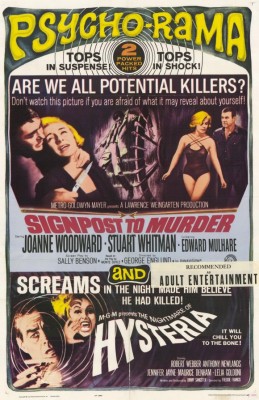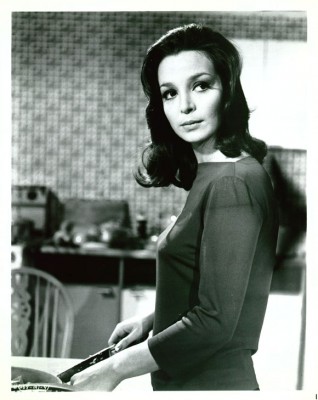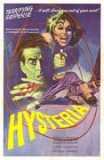| Reviews & Columns |
|
Reviews DVD TV on DVD Blu-ray 4K UHD International DVDs In Theaters Reviews by Studio Video Games Features Collector Series DVDs Easter Egg Database Interviews DVD Talk Radio Feature Articles Columns Anime Talk DVD Savant Horror DVDs The M.O.D. Squad Art House HD Talk Silent DVD
|
DVD Talk Forum |
|
|
| Resources |
|
DVD Price Search Customer Service #'s RCE Info Links |
|
Columns
|
|
|
Hysteria (1965)
This last category was all but owned by Jimmy Sangster, who passed away this past August at the age of 83. He started out as a production manager and assistant director, but found a whole new career after writing The Curse of Frankenstein (1957), Hammer's first worldwide hit. From 1960 onward Sangster wrote relatively few Gothic horrors but he did pen numerous thrillers for Hammer and, later, for American television. A big fan of Henri-Georges Clouzot's Les Diaboliques (1955), Sangster more or less dismissed his own thrillers as pale variations of Clouzot's film. But in fact Sangster's best thrillers are ingenious and original in other ways. Paranoic (1963) and Nightmare (1964) are probably his best for Hammer. The Nanny (1965) and The Anniversary (1968), both starring Bette Davis, are also interesting.
Hammer fans generally regard Hysteria (1965) as the weakest of Sangster's thrillers: "the last - and least - of Hammer's series of Psycho clones," wrote Tom Johnson and Deborah Del Vecchio in their recommended Hammer Films: An Exhaustive Filmography. But Maniac (1963) and Crescendo (1970) are much worse overall, and Val Guest's The Full Treatment (released in the U.S. as Stop Me Before I Kill!, 1961), which Hysteria all but remakes, is downright terrible by comparison. No, Hysteria is perfectly respectable with many fine ideas. It's interesting and genuinely suspenseful and unsettling at times, and though it doesn't hold up to much scrutiny, is highly satisfying.
A remastered Warner Archive Collection, manufactured-on-demand (MOD) title, Hysteria gets a very crisp black and white, 16:9 enhanced widescreen transfer, with a trailer tossed in as an extra feature.
An amnesia patient, going by the name of Chris Smith (Robert Webber), is under the care of psychiatrist Dr. Keller (Anthony Newlands) after fracturing his skull in a single-car accident in which the driver was killed. Smith has recovered physically but has had no luck recovering his memory.
He does, however, fall in love with his nurse, Gina McConnell (Jennifer Jayne). Moreover, he has a mysterious benefactor paying his hospital bills and who upon Smith's release sets him up in the modern and luxurious penthouse of an otherwise unoccupied, half-finished apartment building. Smith hires a private detective, Hemmings (Maurice Denham), to investigate his past. Both try to determine the identity of a mysterious, beautiful woman (Lelia Goldoni) whose photograph, torn from a magazine, was found on Smith's person.
Back in the penthouse flat, Smith begins hearing the same, violent argument between a man and a woman that seems to be emanating from the vacant, unfinished apartment next door.
Directed by cinematographer Freddie Francis, Hysteria, much like Francis's next film, The Skull (1965), does a fine job unpeeling its narrative visually and without a lot of exposition. After an opening scene between Smith and Dr. Keller, most of the next half-hour unfolds without the need of dialogue. And what's shown is often visually interesting, such as the austereness of Smith's ultra-modern, otherwise empty apartment building, underscored with compositions resembling mathematical patterns: Smith among the empty parking spaces in a high-angle shot, looking down; and in the vacant flat next-door, its architecture dominated by windows, each with a big "X" painted on it. Placing Smith alone in a big, empty and half-finished modern building is a clever idea, and one that generates a surprising degree of tension.
Most of the criticism of Hysteria seems levied at American actor Robert Webber and his supposed lack of charisma, but being mealymouthed was Webber's forte. He was relatively handsome but even his facial features always suggested a weakness of character, which served him well in films like 12 Angry Men (1957), and later prolifically on American television, where he guested, usually as a villain, on every conceivable cop and detective show imaginable. Interestingly, from roughly Hysteria's production in the spring of 1964 until around 1968, Webber seems to have been aiming for an film career, appearing in movies exclusively, but before and after that he did loads of TV. He later became associated with director Blake Edwards, giving a fine performance as Dudley Moore's gay songwriting partner in 10 (1979). He died of Lou Gehrig's Disease ten years later. He's just right for Hysteria: a little bit cocky, a little bit troubled, a little bit annoyed. Some find his performance dull but not me. It's realistic and has an appealing everyman quality.
Anthony Newlands, Jennifer Jayne, and Lelia Goldoni, all predominantly British television performers at the time, are excellent in their roles, as is the always reliable Maurice Denham, atypically cast here as an eccentric, surprisingly physical private investigator.
Like Webber, Goldoni is actually an American, though apparently she lived in England from about 1963-72. She's best known for starring in John Cassavetes's Shadows (1959), and later for playing Ellen Burstyn's best friend in Martin Scorsese's Alice Doesn't Live Here Anymore (1974). Exotically beautiful in Hysteria, her air of mystery is further enhanced by what could be a dubbed (and English-accented) performance. I may be wrong, but it sounds like Nikki Van der Zyl, who dubbed various "Bond girls" at this time. Sue Lloyd (The Baron), the ubiquitous Marianne Stone, and wrestler Kiwi Kingston (The Evil of Frankenstein) are also in the cast.
Video & Audio
Part of Warner Home Video's movie on demand program, billed under the "Warner Archive Collection" banner, Hysteria is presented in 1.78:1, 16:9 enhanced widescreen. The aspect ratio listed on the box is 1.85:1, but most of Hammer's films were 1.66:1 and MGM's non-scope movies were at this time 1.75:1, but in any case at 1.78:1 the image is neatly composed. The black and white image is sharp with good contrast, and while the beginnings and ends of reels show some wear, most of the time Hysteria looks great. The mono audio is likewise fine. There are no alternate audio or subtitle options but the disc is region-free.
Extra Features
The lone supplement is a trailer, in 4:3 pillarboxed format. It's pretty lurid but cleverly edited to imply events and twists that don't actually happen in the movie.
Parting Thoughts
Much better than its reputation would suggest, Hysteria is a perfectly enjoyable Jimmy Sangster thriller that starts out extremely well before fading a bit toward the end, but otherwise is nearly par with his best efforts. Highly Recommended.
Stuart Galbraith IV's latest audio commentary, for AnimEigo's Musashi Miyamoto DVD boxed set, is on sale now.
|
| Popular Reviews |
| Sponsored Links |
|
|
| Sponsored Links |
|
|
| Release List | Reviews | Shop | Newsletter | Forum | DVD Giveaways | Blu-Ray | Advertise |
|
Copyright 2024 DVDTalk.com All Rights Reserved. Legal Info, Privacy Policy, Terms of Use,
Manage Preferences,
Your Privacy Choices | |||||||















